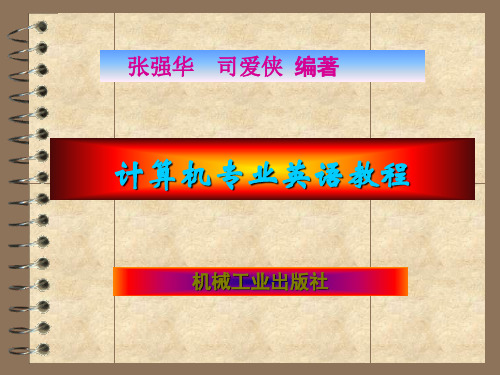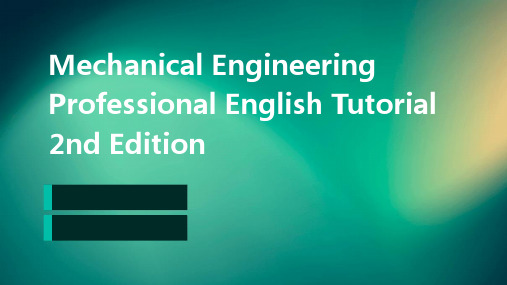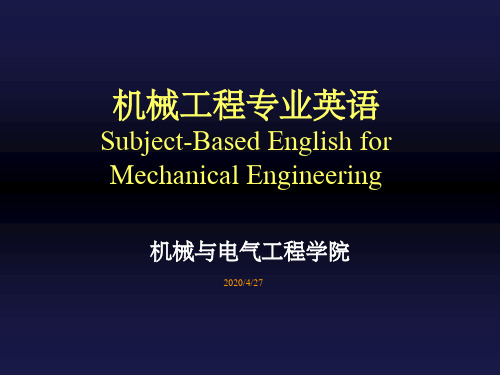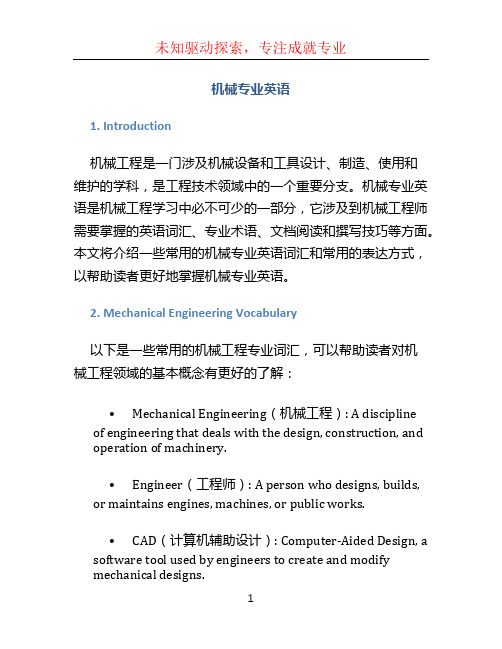机械专业英语阅读教程
机械工程专业英语

机械工程专业英语课程负责人:课程中文名称:专业英语课程英文名称:English for Mechanical Engineering课程类别:选修课程学分数:2课程学时数:32授课对象:机械电子工程专业本科生本课程的前导课程:公共英语,机械专业的相关课程考核方式:平时成绩+期末考试使用教材:《机械工程专业英语教程》施平主编(第3版)电子工业大学出版社教学要求及目的:了解专业英语的语法特点,熟悉专业词汇,逐步培养学生具有比较熟练的专业文献阅读理解能力、翻译能力和英文学术论文的写作能力。
教学方式:课堂讲授、讨论与自学相结合。
以教师讲授为主,引导学生积极阅读指定参考文献,完成课外作业,参与课堂讨论。
有意识地积累与自己研究方向相关的词汇与文献资料,掌握专业英语学习方法。
具体教学目标:●掌握机械工程专业方面的专业名词、专业术语rolling contact bearing, 滚动接触轴承journal bearing, 径向轴承resonance 共振upright drilling machine 立式钻床radial ['reɪdɪəl]drill 摇臂钻床shaper 牛头钻床●掌握习惯表达方式machine design,kinematics [,kɪnɪ'mætɪks] 运动学,动力学dynamic 动态slider-crank mechanism ['mek(ə)nɪz(ə)m] 滑动曲柄机构,assembly drawing 装配图detailed [dɪ'teld]drawing 明细图engineering drawing 工程图degree-of-freedom (DOF) 自由度a four-bar mechanism 四连杆机构vibration mechanism 振动机构CAD Computer - Aided Design, CAM computer-aided manufacturingCAE Computer Aided Engineering●掌握基本的专业文献阅读能力与翻译能力●掌握基本的写作能力●培养基本的专业文献资料检索能力●了解机械工程方面的国内外动向, 并熟悉与机械工程专业相关的其他学科与知识Lesson 1 Translation Skill of Subject-Based English ESP(专门用途英语即专业英语)——English For Specific [spə'sɪfɪk] PurposesEST(科技英语)——English for Science and TechnologyEBE(商业经济英语)——English for Business and EconomicsESS(社会科学英语)——English for Social ScienceEAP(学术英语)——English for Academic PurposesEOP(职业英语)——English for Occupational PurposesESP的语法特点:●名词化●被动语态(1)名词化:The rocket has been developed. For this reason, man can enter space.The development of the rocket makes it possible for man to enter space.随着火箭技术的进步,人类进入太空成为可能。
马棚网机械资讯机械词典大全(第355-627页)

oil inlet flow;进油口流量
oil inlet line;进油口管路
oil inlet opening;进油口
oil inlet passage;进油通道
oil inlet port;进油孔口
oil inlet/outlet port;油进口/出口孔
oil groove side;油槽边
oil guideline;油标志线
oil heater;油加热器
oil hole;油孔
oil hole boss;油孔凸台
oil hole opening;油孔开口
oil hole orientation;油孔定位
oil hose;油软管
oil hose assembly;油软管总成
本文关键字:机械 词典 大全
本文所属专题:
本文访问地址:/news/mechanical_English_vocabulary/2009/8/mapeng_098212048167750.html
上一篇:汽车零部件名称英文译名
下一篇:紧固件的国标德标国标标准号对应明细及其名称
┝机械品质 ┝┉┉质量控制 ┝┉┉检验测量 ┝┉┉体系标准 ┝机械知识 ┝┉┉机械常识 ┝┉┉机械使用 ┝机械软件 ┝┉┉机械设计软件
┝┉┉机械生产软件 ┝┉┉机械分析软件 ┝特色专题 ┝┉┉其它 ┝┉┉实验室 ┝┉┉通用零件 ┝┉┉基础理论 ┝┉┉机械软件 ┝┉┉机电控制
19机械英语文章|机械专业英语自学教程 Lesson 18机械英语文章|机械专业英语自学教程 Lesson 17机械英语文章|机械专业英语自学教程
oil level cap assembly;油位盖总成
unit4 计算机专业英语

Notes
[5]Routing tables are the means by which a router selects the fastest or nearest path to the next “hop” on the way to a data packet’s final destination. 本句中, by which a router selects the fastest or nearest path to the next “hop” on the way to a data packet’s final destination 是一个介词前置的定语从句,修饰和限定the means。on the way to“在……途中”。
学生课下活动设计
阅读Unit4的Reading。完成作业
作业: 我的梦想是成为一家电脑公司的销售经理。 老师告诉同学们别触摸电脑屏幕。 他停下来喝了杯茶。 他努力学习为了通过期末考试。 学校是孩子们学习的好地方。 这些学生经常帮助老师打扫实验室。 昨天我忘了邮信了。 他足够大了可以自己做决定。
教学参考资料推荐
Notes
[3] The MAU does actively regenerate signals as it transmits data around the ring. 本句中,does起强调作用。 [4]Routers contain internal tables of information called routing tables that keep track of all known network addresses and possible paths throughout the internetwork,along with cost of reaching each network. 本句中,called routing tables是过去分词短语,做定语,修饰 和限定internal tables of information。that keep track of all known network addresses and possible paths throughout the internetwork,along with cost of reaching each network是一 个定语从句,修饰和限定routing tables。keep track of是“ 跟踪”。
机械工程专业英语教程(第2版)[施平主编][翻译]_lesson19
![机械工程专业英语教程(第2版)[施平主编][翻译]_lesson19](https://img.taocdn.com/s3/m/1d59be3367ec102de2bd8909.png)
Gear Materials (Reading Material)齿轮材料(阅读材料)Gears are manufactured from a wide variety of materials, both metallic as well as nonmetallic.齿轮由多种种类的材料制造,包括金属材料和非金属材料。
As is the case with all materials used in design, the material chosen for a particular gear should be the cheapest available that will ensure satisfactory performance.在设计中可以使用多种材料的情况下,对于特定齿轮,应当做到选用满足使用要求下的最便宜的材料。
Before a choice is made, the designer must decide which of several criteria is most important to the problem at hand.在作出选择前,设计师必须决定在众多设计准则中哪个是当前最重要的。
If high strength is the prime consideration, a steel should usually be chosen rather than cast iron.如果高强度是第一要考虑的因素,通常就选择钢材而不选择铸铁。
If wear resistance is the most important consideration, a can be made, for problems involving noise reduction, nonmetallic. Materials perform better than metallic ones.如果耐磨性是最重要的因素,可以选用非金属材料要比金属材料更好,同时也可以解决降低噪声的问题。
剑桥国际英语教程第三版1-3目录interchange

Interchange Intro1.It’s nice to meet you2.What’s this?3.Where are you from?4.I’m not wearing boots!5.What are you doing?6.My sister works downtown.7.Does it have a view?8.What do you do?9.Broccoli is good for you.10.I can’t ice-skate very well.11.What are you going to do?12.What’s the matter?13.Y ou can’t miss it.14.Did you have fun?15.Where were you born?16.Can she call you later?Interchange 11.Please call me Beth.2.How do you spend your day?3.How much is this?4.Do you like rap?5.Tell me about your family.6.How often do you exercise?7.We had a great time!8.What’s your neighborhood like?9.What does she look like?10.Have you ever ridden a camel?11.It’s a very exciting place!12.It really works!13.May I take your order?14.The biggest and the best.15.I’m going to a soccer match.16.A change for the better.Interchange 21.A time to remember2.Caught in the rush3.Time for a change!4.I’ve never heard of that5.Going places6.OK. No problem!7.What’s this for?8.Let’s celebrate!9.Back to the future10.I don’t like working on weekends!11.It’s really worth seeing!12.It could happen to you.13.Good book, terrible movie!14.So that’s what it means!15.What would you do?What’s your excuse?下面是三个励志小故事,不需要的朋友可以下载后编辑删除谢谢!!!你可以哭泣,但不要忘了奔跑2012年,我背着大包小包踏上了去往北京的火车,开启了北漂生涯。
机械工程及自动化专业课程

机械工程及自动化专业课程篇一:机械工程及自动化专业课程简介第一部分:机械工程及自动化专业课程简介课程名称:工程图学学分数:7 总学时数:112 课程内容:正投影原理和基础知识;点、直线、平面的投影特性和相对位置;立体表面交线(截交线、相贯线)的投影;绘制和阅读组合体视图;形体构型设计基本方法;机件的各种表达方法;机件的尺寸标注;标准件与常用件;计算机交互绘图;零件图和装配图的绘制和阅读。
教材: 1.大连理工大学工程画教研室.画法几何学.北京:高等教育出版社,2003年7月第6版;2.大连理工大学工程画教研室. 机械制图. 北京:高等教育出版社,2003年7 月第 5 版。
前修课程:平面几何,立体几何。
课程名称:电工技术学分数: 3 总学时数:48 课程内容:本课程是高等工科院校机械工程及其自动化、医学影像专业的一门专业技术基础课程,是研究基本电路、基本磁路的应用科学,是该专业高新技术发展的基础学科。
它的主要内容包括:电路的基本概念及分析方法;电路的暂态分析;单相和三相交流电路的计算和分析;磁路与铁心线圈电路的基本定律和应用;交直流电机及其特性的研究;工业企业供电与安全用电;继电接触器控制系统的研究。
教材:秦曾煌主编.电工学(第6版)(上册). 北京:高等教育出版社。
前修课程:高等数学,大学物理。
课程名称:工程材料及机械制造基础学分数: 5 总学时数:80课程内容:工程材料及机械制造基础是研究机器零件常用材料和加工方法,即从选择材料,制造毛坯,直到加工出零件的综合性课程。
它是高等学校工科机械类专业必修的技术基础课。
学生在金工实习的基础上,通过本课程的学习,获得常用工程材料及零件加工工艺的知识,培养工艺分析的初步能力,并为学习其他有关课程及以后从事机械设计和加工制造工作奠定必要的基础。
通过本课程学习,学生将掌握常用工程材料的种类、成分、组织、性能和改性方法,具有选用工程材料的初步能力。
掌握主要加工方法的基本原理和工艺特点,具有选择毛坯、零件加工方法及工艺分析的初步能力。
机械工程专业英语教程第2版

In the field of mechanical engineering
• Mechanical engineers work in various industries, including automotive, aerospace, energy, manufacturing, and more.
Mechanical Engineering Professional English Tutorial 2nd Edition
目 录
• introduce • Fundamentals of Mechanical
Engineering • Professional vocabulary and
expressions • Professional literature reading and
03
流畅自然的表达
在保证准确性的前提下,使译文 流畅自然,符合中文的表达习惯, 易于读者理解。
05 Practical application and case analysis
Mechanical Design Cases
机械类专业英语应用教程

本文将针对机械类专业英语应用进行详细介绍和演示,以帮助读者更好地掌握相关知识和技能。
1. 了解机械类专业英语的重要性机械类专业英语作为机械工程专业的基础,对于从事机械设计、制造、维修等工作的人员来说,具有至关重要的作用。
它不仅是与国际交流、合作密切相关的语言工具,也是理解和应用专业知识的必备工具。
2. 学习机械类专业英语的方法和技巧在学习机械类专业英语时,可以采取以下方法和技巧来提高效果:- 注重基础词汇的积累:掌握机械工程领域常用的英文词汇和术语,如机械零件、工艺流程、材料性质等。
- 学习专业文献的阅读:阅读关于机械工程领域的英文期刊、论文和专业书籍,提高对专业知识的理解和运用能力。
- 参与专业英语交流:积极参与机械类专业英语的听说训练,培养用英语进行专业交流和表达的能力。
3. 机械类专业英语应用场景机械类专业英语在机械工程领域有广泛的应用场景,包括但不限于以下方面:- 机械设计与制造:掌握机械设计和制造的相关英文词汇,能够理解和编写设计文件、技术规格和操作手册等。
- 机械维修与检测:了解机械故障排除和设备检测的英文表达,能够与国际维修团队进行有效沟通。
- 自动化与控制系统:学习自动化和控制系统领域的英文术语和技术,能够阅读和编写相关技术文档。
4. 高效学习机械类专业英语的建议为了高效学习机械类专业英语,建议采取以下策略:- 制定学习计划:合理分配学习时间,确保每天都有固定的学习时间进行机械类专业英语的学习和练习。
- 运用多种学习资源:利用学习资料、教材、网络资源等多种途径进行学习,提高学习效果。
- 反复实践和巩固:通过大量的练习和实践,熟练掌握机械类专业英语的用法和表达方式。
5. 结语通过本文的介绍和演示,相信读者已经对机械类专业英语应用有了更深入的了解。
在今后的学习和工作中,希望读者能够不断提升自己的机械类专业英语能力,实现更好的发展和成就。
机械工程专业英语精ppt课件

专利检索资源荟萃(二)
8.美国专利检索:/patft/index.html 9.欧洲专利检索:/ 10.从ESPACENET数据库提取世界各国专利文献的方法(国知局提供): /sipo/wxfw/ytwggsjkjs/ytwzlsjkjs/ESPACENET.doc 11.欧洲专利局免费专利数据库(含欧洲各国家入口): /access/index.en.htm 12.欧洲专利局专利数据高级检索(含欧洲、PCT和世界范围三个数据库): /advancedSearch?locale=en_ep 13.欧洲专利法律状态查询:/portal/public/registerplus 14.PCT专利检索:http://www.wipo.int/pctdb/en/ 15.英国专利检索:/search/index.htm
专利检索资源荟萃(一)新!专利搜索网址:/ 1.因特网专利数据库介绍(中华人民共和国国家知识产权局): /sipo//wxfw/ytwzlsukjs/ytwzlsjkjs/200508/t20050816_67485. htm
机械工程专业英语ቤተ መጻሕፍቲ ባይዱ
Subject-Based English for Mechanical Engineering
机械与电气工程学院
2020/4/27
教学要求及目的
了解专业英语的语法特点,熟悉专业词汇, 逐步培养学生具有比较熟练的专业文献阅 读理解能力、翻译能力和英文学术论文的 写作能力。 掌握国外英文专利和文献资料的查询方法, 能以英语为工具,获取本专业所需信息。 了解国际学术交流的常用表达方式。
Lesson 37 Milling Machines and Grinding Machines Lesson 38 Drilling Operations Lesson 44 Nontraditional Manufacturing Processes Lesson 62 The Computer and Manufacturing Lesson 63 Computers in Design and Manufacturing Lesson 64 Computer-Aided Analysis of Mechanical Systems Lesson 65 Computer-Aided Process Planning Lesson 66 Numerical Control Lesson 71 Industrial Robots Lesson 77 Technical Report Elements Lesson 78 Writing the Technical Report Extra lesson 1 English for International Academic Exchange Extra lesson 2 Expression of Numbers, Signs, Equations and Graphs in English Extra lesson 3 Professional Literature and Patent Retrieval
2012春季目录大连理工大学出版社

978-7点击职业英语---基础英语模块互动课本2 900774-13-
24 25 26 27 28 29 30 31 32 33 34 35 36 37 38 39 40 41 42 43 44 45 46 47 48 49
4740·5 4737·5 4739·9 4738·2
点击职业英语----基础英语模块3 学生频道 点击职业英语----基础英语模块3 听说频道 点击职业英语----基础英语模块3 练习频道 点击职业英语----基础英语模块3 教师频道
50 51 52 53 54 55 56 57 58 59 60 61 62 63 64 65 66 67 68 69 70
5412-0 5748-0 6036-5 2578-6 2952-4 3215-9 3732-1 3730-7 2577-9 2953-1 2945-6 3497-9 5726-8 5926-2 5949-1 5774-9 2592-2 2762-9 3842-7 4537-1 6458-7
许辉 许辉 编委会 杨涌泉 杨涌泉 鄢曜来 闻君 郭静 付万荣 刘燕波 刘燕波
27.00 25.00 20.00 32.00 32.00 22.00 25.00 23.50 23.00
117 118 119 120 121 122 123
2382-9 4575-3 2575-5 3051-3 4700-9 4037-6 3618-8
978-7点击职业英语---基础英语模块互动课本3 900774-144736·8 4733·7 4735·1 4734·4 点击职业英语----基础英语模块4 学生频道 点击职业英语----基础英语模块4 听说频道 点击职业英语----基础英语模块4 练习频道 点击职业英语----基础英语模块4 教师频道
机械专业英语 (2)

机械专业英语1. Introduction机械工程是一门涉及机械设备和工具设计、制造、使用和维护的学科,是工程技术领域中的一个重要分支。
机械专业英语是机械工程学习中必不可少的一部分,它涉及到机械工程师需要掌握的英语词汇、专业术语、文档阅读和撰写技巧等方面。
本文将介绍一些常用的机械专业英语词汇和常用的表达方式,以帮助读者更好地掌握机械专业英语。
2. Mechanical Engineering Vocabulary以下是一些常用的机械工程专业词汇,可以帮助读者对机械工程领域的基本概念有更好的了解:•Mechanical Engineering(机械工程): A discipline of engineering that deals with the design, construction, and operation of machinery.•Engineer(工程师): A person who designs, builds, or maintains engines, machines, or public works.•CAD(计算机辅助设计): Computer-Aided Design, a software tool used by engineers to create and modifymechanical designs.•CAM(计算机辅助制造): Computer-Aided Manufacturing, a software tool used to controlmanufacturing processes.•CNC(计算机数控): Computer Numerical Control,a method of controlling manufacturing machines usingcomputers.3. Common Expressions in Mechanical Engineering在机械工程领域,有一些常用的表达方式,以下是一些示例:•According to the design specifications(根据设计规范): Indicates that something is done in accordance with the design requirements.•The machine is in operation(机器正在运行): Indicates that the machine is currently running andperforming its intended function.•The material is heat-treated(材料经过热处理): Indicates that the material has undergone a specific heat treatment process for improved properties.•The system is experiencing mechanical failure(系统发生机械故障): Indicates that the system is notfunctioning properly due to a mechanical issue.•The component needs to be lubricated regularly(零部件需要定期加润滑油): Indicates that regularlubrication is required to ensure proper functioning of the component.4. Reading and Writing Documents in Mechanical Engineering在机械工程领域,阅读和撰写文档是非常重要的技能。
机械设计专业资料汇总

机械设计专业资料汇总机械设计是一门重要的工程学科,涉及到机械器件、机械系统和机械工程的设计、分析和制造。
对于学习和从事机械设计的人来说,获得全面、准确的专业资料是非常重要的。
在本文中,我们将汇总一些机械设计专业资料,供学习和参考使用。
1. 机械设计手册:机械设计手册是机械设计师必备的工具书之一。
它收录了大量的机械设计所需的基本原理、技术参数、计算公式和设计方法,涵盖了机械设计的各个方面,包括机械元件、机械传动、机械结构、机械加工等。
机械设计手册不仅可以作为学习工具,还可以作为实际设计时的参考书。
2. 机械工程数据库:机械工程数据库是汇集了大量机械工程相关的文献、期刊和会议论文的在线资源。
通过机械工程数据库,可以方便地查找和获取最新的研究成果和技术进展,了解前沿的机械设计理论和应用实践。
3. CAD软件教程:计算机辅助设计(CAD)已成为现代机械设计的重要工具。
通过学习CAD软件教程,可以掌握CAD软件的基本操作和设计技巧,提高设计效率和质量。
常用的CAD软件包括AutoCAD、SolidWorks、CATIA等。
4. 机械设计课程教材:机械设计相关的课程教材是系统学习机械设计理论和方法的重要资源。
这些教材通常包括机械设计的基本原理、设计流程和案例分析,以及相关的数学、力学、材料学等基础知识。
根据个人的学习需求和专业方向,选择适合自己的机械设计课程教材进行学习。
5. 设计手册和规范:机械设计中的许多参数和标准都有相应的设计手册和规范。
这些手册和规范包括国家标准和行业标准,提供了机械设计中各种材料、工艺、尺寸和公差的要求和推荐值。
了解和应用这些设计手册和规范,可以确保设计的合理性和可制造性。
6. 机械设计案例和工程实践:了解和学习实际的机械设计案例和工程实践是提高机械设计能力的重要途径。
通过分析和借鉴优秀的设计案例,可以掌握先进的设计理念和方法;通过参与实际的机械设计项目,可以锻炼实际问题解决的能力和团队合作精神。
新视野大学英语第三版读写教程2section B阅读与翻译

UNIT1马尔科姆·艾克斯是一位非裔美国民权活动家、宗教领袖、作家和演说家。
他生于1925 年,1965 年被神秘地暗杀。
在他去世之前,他对自己生平的自述——《马尔科姆·艾克斯自传》已闻名遐迩。
他出生于一个贫民家庭,取名马尔科姆·利特尔。
后来,他加入了一个叫“伊斯兰民族”的组织,之后改名为马尔科姆·艾克斯。
“伊斯兰民族”是个宗教团体,它改变了美国主流伊斯兰教的一些主要的习俗和信仰,使之更适用于19 世纪60 年代早期非裔美国人的特定情况。
马尔科姆·艾克斯因当时犯有诸如偷窃等罪而入狱。
他在监狱里得知了“伊斯兰民族”组织。
由于没有受过良好的教育,他在向别人传授他的新信仰时感到力不从心。
作为一名年轻人,他可以用草根语言来概述自己的想法,语言简单、粗浅、语法差劲,且词汇贫乏。
可作为一名成年人,当他在大型公众集会上向人们阐述他的新信仰时,他发觉自己缺少了所需的语言交流技能。
用他自己的话说,他“甚至没有这个功能”。
为了增长知识,提高沟通技能,深陷绝望的马尔科姆·艾克斯为自己制定了一个计划。
他决定求助于书籍,相信书会使他受益匪浅。
可是当他试图阅读一些严肃的书本时,他不禁倍感苦恼,因为大部分的词他都不认识。
他写道:“这些书还不如是用中文写的。
”他跳过了所有不认识的词,可是最终他全然不知这本书里写了什么。
马尔科姆·艾克斯在他的自传里谈到他贫乏的语言技能时是这样写的:“我变得沮丧起来。
”由于无法阅读和写作所遭受的巨大挫折促使马尔科姆·艾克斯开始探索如何攻克自己的语言缺陷。
他说:“我明白我所能做的就是弄到一本词典来学习,学一些单词。
”他也幸运地意识到应该尝试去改进他的书写。
他告诉我们:“令人伤心的是我甚至不能把英文书写得整齐。
”这些想法促使他向狱管请求,要了一些纸和铅笔。
头两天,马尔科姆·艾克斯只是很快地浏览了一下词典,试图在这不熟悉的格式里寻找出他自己的应付方法。
《专业英语说课》PPT课件

动的英语学习方式。
返回
10
精选课件
网站
❖ /p96514794550.html 本教材全文电子档
❖ /国际电气工程 师学会
❖ /美国 自动化杂志
❖/ 爱词霸在线 词典
任务驱动法
模拟套写 互译练习
Simulated Writing
提问法、讲授法、 师生互动法
精读 泛读 问答 复述
Reading and Translating
6
精选课件
课堂教学环节
Step Ⅰ
情境导入
Step Ⅱ
训练与指导
Step Ⅲ
拓展应用
Step Ⅳ
能力检测
7
精选课件
四、教学对象分析
学生
教师
3
精选课件
课程教材采 用高等教育 出版社出版 《机电英语 》教材编写 组 编写的《
机电英语》 (第二版)
课程教材
本教材内容新 颖、实用、贴 近现实。本教 材可作为各大 院校机电一体 化、机械制造 及自动化、数 控技术应用、 电气自动化等 专业的专业英
语教材 。
4
精选课件
第一部分 阅读与翻译 第二部分 模拟写作
❖ /englis h/ 在线英语听力室
11
精选课件
六、教学效果
Effect
1
学生学 习英语 兴趣较 为浓厚
2
掌握了与 专业相关 的英语术 语、词汇
3
具备专业 英语的听 说读写译 能力
4
具有 自主 学习 能力
12
精选课件
Good-bye!
13
精选课件
基础 能力 薄弱
缺乏 信心 兴趣
实际 应用 能力差
机械原理教程申永胜第三版

机械原理教程申永胜第三版
【原创版】
目录
1.教程简介
2.教程内容
3.作者介绍
4.第三版更新内容
5.适合读者
正文
《机械原理教程申永胜第三版》是一本关于机械原理的专业教材。
本教程旨在帮助读者理解和掌握机械原理的基本知识和应用,内容涵盖了机械原理的各个方面,包括机构的结构、运动、力学分析等。
教程内容丰富,结构清晰,适合作为本科院校、高职高专等机械类专业的教材。
全书共分为十五章,第一章为绪论,介绍了机械原理的基本概念和研究方法;第二章至第十五章分别详细介绍了机构的结构、运动、力学分析等方面的内容。
作者申永胜教授是我国著名的机械原理专家,具有丰富的教学和科研经验。
他在书中结合实际工程应用,为读者提供了大量实例,以便读者更好地理解和掌握机械原理。
第三版相较于前两版,更新了许多内容,增加了一些新的章节和实例,以适应当前机械工程领域的发展需求。
同时,书中的部分习题和案例也得到了优化和更新,以提高读者的实际应用能力。
本教程适合于机械类专业的本科生、研究生以及从事机械工程领域的技术人员阅读和参考。
通过学习本教程,读者可以系统地掌握机械原理的基本理论和应用方法,为今后的学习和工作打下坚实的基础。
陈世丹:《新编MPA英语阅读教程》第三版课件

4. These appointees, while functioning as top managers significant management responsibilities, are seldom professional managers and seldom think of themselves as management experts.
5. When Disney’s famous mouse made it big in the 1930s, he appeared in a variety of cartoon shorts that had him building something (such as a house or a boat) that would later fall apart, or generally going to a great deal of trouble for little result. 解析:连词When引导的时间状语从句中的短语made it big 意为“获得成功”。关系代词that引导的定语从句中宾语 him后面跟了两个现在分词短语building something… 和going to…做宾语补足语。 译文:当迪斯尼的著名老鼠在20世纪30年代大获成功,它 出现在各种各样的动画短片中,它或是建造后来崩溃的东西 (如一幢小房或一只小船),或是经常为了微不足道的结果 而遇上大量的麻烦。
公共管理是艺术,不是科学——抑或反之
有些人有管理天赋。我们都见过这种天生的管理 者。他们不仅能长久地条理清晰,还有组织人一起和 谐工作的特殊能力。管理的艺术在于处事公正,灵活, 具有常识。但是没有工具——没有消化和传达信息的技 能(科学)——艺术家是毫无用处的。争论公共管理到 底是艺术多一点还是科学多一点是毫无意义的。它是 两者兼具的。当然,有更多的科学知识,你会是一个 更好的艺术家。但是如果你没有艺术上的天赋,书本 上的知识是不能让你成为一个艺术家的。 美国内战开始时,无论是战争艺术还是战争科学, 亨利•威戈•哈莱克也许是北方军中最博学的了。他所 任教的西点军校用他的书《军事艺术和科学的要素》 (1864年)和他翻译的许多外国军事教材作为教科书。
DISCOVRY中文教程主体

GeoGraphix Discovery 教程说明本教程通过提供现实的一体化地球科学解释工作流程的实地实例,为新用户介绍GeoGraphix Discovery的主要功能。
教程囊括了组成GeoGraphix Discovery 的大部分模块(除了LeaseMap、SeisBase、ZoneManager、CoordMgr、WellXchange、pStax、LogM 和STRUCT之外),并且用石油地质学家熟悉和了解的日常工作流程分步骤演示。
本教程涵盖的地质研究工作流程如下:第一章建立工区第二章输入人文地理建筑和井数据第三章建立底图第四章在底图上粘贴井数据第五章井数据查看和质量控制第六章横剖面上顶层拾取和相关对比第七章曲线地质解释第八章建立地震解释第九章制作地震解释曲线图第十章测井曲线分析和解释第十一章制作测井曲线解释等值图本教程的用户必须完成第一、二章的所有步骤。
第二章以后,用户可以学习完成整个工作流程(如果授予许可证,在任何GeoGraphix 模块的主菜单条的Help>>About<module name>的所有模块中都有整个工作流程教程),或学习完成几个第二章结尾(45页)提供的简化工作流程选项什么是GeoGraphix Discovery?欢迎使用GeoGraphix Discovery – GESXplorer、PRIZM、SeisVision 和GMAplus。
GeoGraphix Discovery是基于先进的Windows NT?/ Windows 2000?的、方便研究人员桌面使用的一体化解释软件。
整套释放版GeoGraphix Discovery 的组成有:GESXplorer:一体化地质解释系统,包括绘图(GeoAtlas和LandNet)、网格制作和曲线制作(IsoMap)、矢量和光栅测井曲线的解释性剖面(X剖面)。
PRIZM: 为研究人员设计的多井测井曲线分析系统,用于评价、分析、管理和操作测井数据,确定油藏模型。
- 1、下载文档前请自行甄别文档内容的完整性,平台不提供额外的编辑、内容补充、找答案等附加服务。
- 2、"仅部分预览"的文档,不可在线预览部分如存在完整性等问题,可反馈申请退款(可完整预览的文档不适用该条件!)。
- 3、如文档侵犯您的权益,请联系客服反馈,我们会尽快为您处理(人工客服工作时间:9:00-18:30)。
Engineering drawing is not only the province of the draftsperson. It is the language of the engineer. It is their means of developing and recording their ideas, and conveying them to others. Every engineer will be using and referring to some form of drawings almost every day. They will often be producing or directing the preparation of drawings. Usually, they make the preliminary sketches and design drawings in accordance with principles of engineering drawing, because this is the most unambiguous way to convey and record information. It is also likely that every engineer at sometime will be checking the work of designers and drafters and approving drawings before they are sent to manufacturing. When engineers sign off the final approval of a drawing, they take responsibility for it. An overlooked error in the drawing could be costly. So a drawing must be true and complete statement of the figure, dimension and technical requirements, expressing the way that the part is to be manufactured. Mechanical drawing is a process which relies heavily upon research in the principles of representation, interpretation and related technical standards. Typical drawings in machine manufacturing are classified as part drawings and assembly drawings. Detailed introducing is as followed
(1)Part drawings
Part drawings are frequently used as instruction fo manufacture and inspection of the parts. An integrated part drawing should include a set of drawings, overall
dimensions, necessary technical requirements and full contents of title block.
A set of drawings: some representation can be given to properly show the internal and external shape of the part.
Overall dimensions: specifying the requirements for manufacture and inspection of the part integrity .
Necessary technical requirements: codes, symbols and notes are used to describe the essential technical requirements in the process of manufacture, inspection and assembly, such as surface roughness, tolerance, heat treatment,case treatment and the like.
Full contents of title block: including the part name, materials, drawing number, scale and signature of responsible individual.
Assembly drawings are used in explaining machines or components. In mechanical design, part drawings are usually related to the assembly drawing which indicates the working principle and structure of a machine or component. In the process of machine manufacturing, the drawinings are to allow machining of the metal based on the part drawing and assembling to create a unit or a machine in due course as well as in operation and maintenance. 2. Representation of machine elements Mechanical drawings in national standards are restricted to those which specify the view, sectional view and broken sectional view to represent the structures and shapes.
Views are projection drawings of the object. Typical views include basic views, directional views, partial views and oblique views. Basic views include upward view, front iew, vertical view, right view, left view and back view, as shown in Fig. 1-2-1. The number of views is always six, four and three, four is the typical views.
Fig 1-2-1Basic views
Sectional views are used to show the internal structure of the object with a dash line. When parts have complex internal geometries, knowing the interior is as important as knowing the exterior, you can use sectioning technique to cut sections' across the object to show internal details.We divide sectional views into full sectional views, half sectional views and partial
sectional views.
Broken sectional views are supposed to be sectional plane at a point somewhere on the machine element.We divide them into removed broken sectional view and superposition sectional view.
For expressing the structure and size of a component distinctly, we put a component into a three-plane projection system, and acquire the three-dimensional drawing in the three projection plane. The basic principle is indicated as equal length in the front view and vertical view, equal height in the front view and left view, equal width in the vertical view and left view.
The axonometric drawing is used for complementing the outline of the body. The common axonometric drawing combines isometric projection with oblique biometric projection.。
